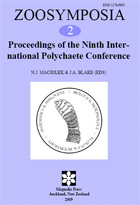Abstract
The fine structure of mouth parts was studied in 19 species from 13 genera belonging to the three families that are known to have a soft non-muscular axial proboscis: Orbiniidae, Opheliidae, and Scalibregmatidae. Four types of mouth structures divergent from the simple non-muscular axial proboscis were found. (1) A bubble-like symmetrical ciliated proboscis was found in both Ophelia and Euzonus, genera in the subfamily Opheliinae. A similar mouth structure is known for Paraonidae, Capitellidae, and some Maldanidae. (2) A folded symmetrical axial proboscis with well-developed ciliated lobes that form a complicated structure with intricate patterns; the mouth opening is terminal, and the whole structure is symmetrical. Orbiniidae, Scalibregmatidae, and Travisia (Opheliidae) have this type. (3) An asymmetrical dorsal lobed proboscis. The plane of asymmetry is dorsoventral. It is a tongue-like lobed or flattened eversible structure. The mouth opening is situated below and behind it. When inverted into the pharyngeal cavity, the entire structure is rooted dorsally. It is found in all studied species of Ophelina and Polyophthalmus and in Armandia brevis. (4) Oral tentacles (about 12 ciliated tentacles). When retracted, the oral tentacles are situated dorsally in the pharyngeal cavity, similar to the folds of an asymmetrical lobed proboscis (type 3). Contractor muscles and vascular vessels are found inside the cavity of the tentacles. This type is found in Armandia maculata and A. leptocirrus. A tentative scheme of transformation of the soft axial proboscis is presented. Three main trends of proboscis transformation in the Scolecida are discussed: (1) enlargement of the ciliated surface of the proboscis by the development of numerous folds and intricate patterns, (2) appearance of an asymmetrical proboscis, and (3) transformation of the asymmetrical dorsal lobed proboscis into oral tentacles.

